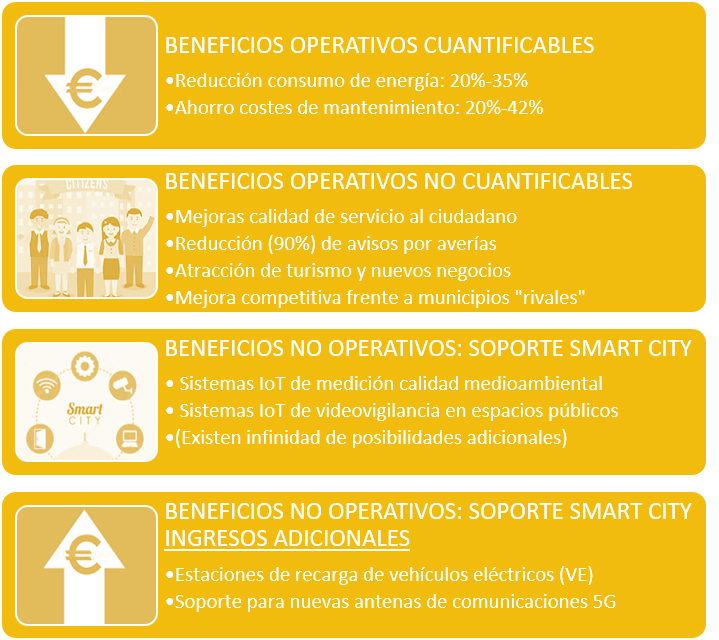The emergence of new IoT LPWAN technologies, such as NB-IoT© and LoRaWAN©, have represented a true revolution for point-to-point lighting remote management systems, allowing their deployment with really low device costs (luminaire control nodes) and infrastructure (LPWAN network cost), and a quality of unprecedented service. The installation cost of this type of system, when it coincides with the renewal of the luminaires, is practically non-existent, as they are Plug & Play solutions.
The combined use of panel control systems and individual luminaire control systems provides a series of benefits for the municipality, which we can categorize as shown in the header image.
«The non-operational benefits that this type of systems provide for municipalities and their citizens, as well as the possibility of renting or using the lighting network (keeping the lights off during the day, but with power) to generate new income, are issues "strategic actions whose importance for the future of any municipality is several orders of magnitude greater than the initial economic profitability."
Depending on the type of installation, and the effective use that lighting managers make of the individual luminaire control system, the return on investment (ROI) periods are between 3 and 5 years. In the calculations of this return, only the quantifiable direct benefits mentioned above are considered: saving energy consumption and reducing maintenance costs. The non-quantifiable benefits and those provided by Smart City applications, which use the lighting infrastructure as support, have not been considered. In these calculations, no additional income has been considered from renting streetlight poles for applications such as EV charging stations, or mounting 5G antennas.
It is tempting to economically quantify the indirect non-operational benefits that any of the Smart City applications described can offer, for which an individual luminaire remote management system is required. In particular, it would not be difficult to estimate how much money a 5G mobile communications operator would be willing to pay for “renting” the poles of the lights to install their new antennas, compared to other network deployment alternatives that are much more expensive for them. Nor would it be difficult to estimate how much a concessionaire company for EV charging stations, installed on streetlights, instead of being installed in expensive special anti-vandal cabinets, would be willing to pay the municipality.. However, we will not give in to that temptation, to prevent the reader from perceiving an overestimation of the figures. However, we can say that any of the applications mentioned above, by themselves, can justify the implementation of a luminaire control system in any municipality.
We can conclude that the investment in a point-to-point lighting remote management system, when implemented simultaneously with the renewal of the luminaires, is amortized in the first years of useful life of the new luminaires, only with the savings in energy consumption and maintenance. However, the non-operational benefits that these types of systems provide for municipalities and their citizens, as well as the possibility of renting or using the lighting network (keeping the lights off during the day, but with power) to generate new income, They are strategic issues whose importance for the future of any municipality is several orders of magnitude greater than the initial economic profitability.
